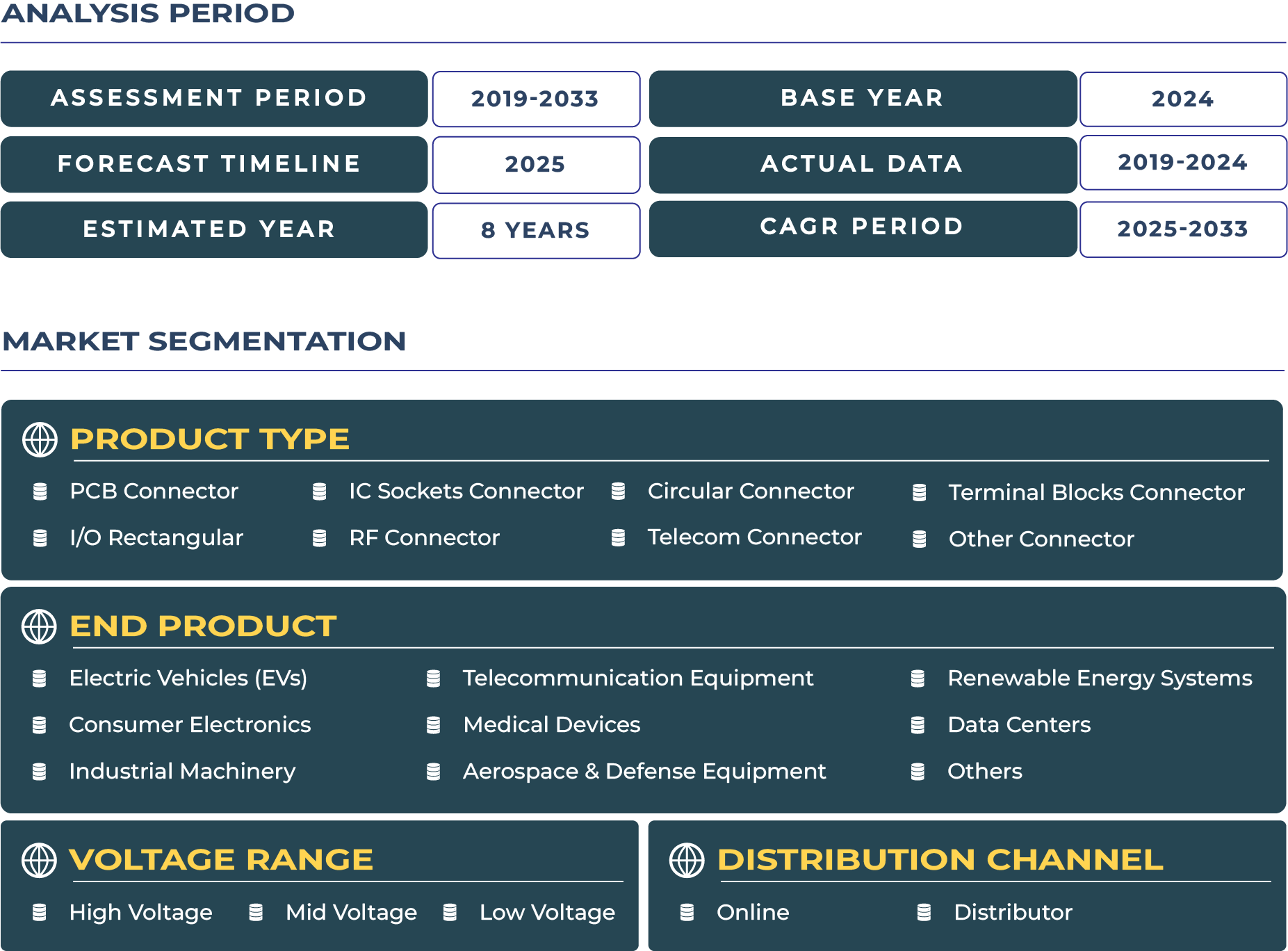Zimbabwe Connector Market Outlook
Smart and Traceable Connector Systems Fueling Zimbabwe’s Urban and Security Tech Growth
Zimbabwe’s urban technology agenda and biometric infrastructure deployment are rapidly influencing the structure and direction of its connector market. The country’s increasing investment in smart city architecture, digital identity platforms, and public safety networks is driving demand for high-integrity connector systems embedded with RFID/NFC and built using traceable, simulation-aided design processes. As Zimbabwe transitions into a digitally governed economy with an emphasis on compliance, safety, and data transparency, connectors are evolving into critical components that facilitate secure, interoperable, and field-resilient operations.
DataCube Research estimates that Zimbabwe connector market is projected to expand to USD 71.9 million by 2033, registering a CAGR of 6.5% during the forecast period. This growth is attributed to the acceleration of biometric voter systems, digital surveillance infrastructure, and solar energy grids—each demanding connectors capable of supporting long lifecycle durability, data encryption compatibility, and environmental compliance. Circular and RF connectors embedded with traceable chips and validated through AI-based CAD/EDA tools are leading this transformation, particularly in urban surveillance, renewable power setups, and secure authentication systems.
Cultural Expression and Digital Media Projects Propel Hardware-Backed Connectivity
Zimbabwe’s connector ecosystem is benefiting from the rise in multimedia and state-backed storytelling platforms that require professional-grade production and broadcasting infrastructure. As short films, video blogs, and community cinema grow in popularity—amplified by the country’s National Film Strategy—video production kits, lighting systems, and control boards with secure magnetic and I/O rectangular connectors are increasingly deployed across the country. This creative energy is spilling over into semi-professional gear demand, opening new market spaces for modular, safe-lock connector systems.
Additionally, the cultural push for digital expression in schools and community centers is fostering the deployment of educational tablets and digital signage—platforms that rely on reliable and tamper-resistant connector types. However, persistent barriers such as high data costs and low private investment in hardware manufacturing constrain local innovation in connector sub-assemblies. Many advanced connectors still depend on imports, inflating end-device costs and delaying broader market penetration.
Limited localized tooling facilities also restrict the development of indigenous connector variations tailored to Zimbabwe’s environmental and mechanical demands. This scenario underscores the need for compliance-first connector designs that are pre-certified and field-tested for Zimbabwe’s conditions.
Media Innovation and Studio Development Spur Demand for Modular, AI-Certified Connector Solutions
Zimbabwe’s digital transformation is being shaped by the convergence of public broadcasting reforms and grassroots media growth. Reforms within the Zimbabwe Broadcasting Corporation (ZBC), including digital migration and localized content generation, are fostering fresh demand for studio-grade, reconfigurable connector systems that meet global interoperability standards. These use cases require high-frequency RF connectors and modular terminal blocks that support signal clarity in mobile production and cloud-based editing workflows.
The emergence of local production studios—driven by diaspora funding and international co-productions—is opening a clear path for the adoption of simulation-ready connector kits. These kits are embedded with RFID for inventory traceability and designed using AI-optimized EDA platforms to meet international safety and lifespan benchmarks. As wearable cameras, sensor-enabled broadcasting rigs, and telepresence robotics find their way into production suites and event platforms, Zimbabwe’s connector market is adapting by blending power, signal, and traceability in a compact, field-configurable format.
The growing popularity of short-form media on TikTok, Facebook Reels, and WhatsApp Video has made compact, consumer-grade connectors mainstream in audio-visual content creation. This growth is not only sustaining demand for low-latency connectors but also creating opportunities for locally branded connector packaging and post-sale customization.
Electrification Funding and Digital Access Programs Drive Connector Scalability Potential
Zimbabwe’s broader economic trends are increasingly aligning with the connector sector. Electrification investments—supported by mini-grid development and solar rural rollout campaigns—are leading to demand for outdoor-grade, moisture-sealed, and sand-resistant connector systems. Circular and terminal block connectors designed to operate in variable voltage, dust-prone, and open-air environments are seeing higher demand, particularly in low-income energy access projects across Masvingo, Matabeleland, and Manicaland.
According to IMF projections, Zimbabwe’s GDP is expected to grow by an average of 3.5% between 2025 and 2030, buoyed by energy modernization, ICT investment, and services digitization. This economic momentum is supporting demand for connector types that can support longer deployment cycles, low maintenance, and resilience against environmental degradation.
Moreover, donor-funded digital access programs focused on schools, clinics, and e-governance terminals require components that are pre-certified and compliant to avoid procurement delays. This creates a clear competitive advantage for connector manufacturers that align with regional sustainability goals, digital transformation KPIs, and traceability standards.
Traceability and Compliance-Oriented Connector Strategies Fuel Market Differentiation
The Zimbabwean connector market is maturing with a clear emphasis on traceability, safety, and simulation-first design validation. Other international firms, including Phoenix Contact and HARTING, are scaling their regional operations by integrating their industrial connector kits with localized partner networks. These firms are adopting a compliance-first design strategy—offering documentation support, repair protocols, and connector lifecycle management platforms that align with Zimbabwe’s electrification and biometric security goals.
Emerging startups are experimenting with 3D-printed connector shells and biodegradable connector casings to align with the country’s environmental compliance efforts. These niche innovations, coupled with government-backed hardware incubators in Harare and Bulawayo, are beginning to build indigenous connector design capacity.
Zimbabwe Connector Market Anchored by Urban Transformation and Compliance-Driven Innovation
Zimbabwe connector market is undergoing a transformation—evolving from commodity sourcing to system-level innovation, driven by biometric compliance, digital broadcasting reforms, and smart city deployment. The shift toward RFID/NFC-embedded connectors, compliance-first designs, and AI-modeled simulations reflects the nation’s ambition to build secure, traceable, and locally relevant hardware ecosystems.
With rising electrification investment, expanding medtech infrastructure, and evolving media platforms, connector firms that prioritize modularity, documentation, and traceability will gain sustained traction. Zimbabwe’s connector landscape is no longer a passive supply chain node but an emerging market with strategic design and compliance implications.







